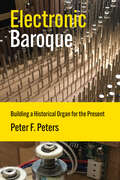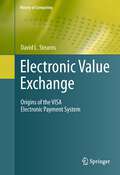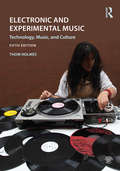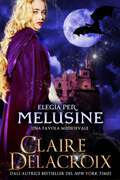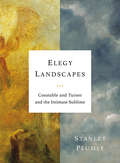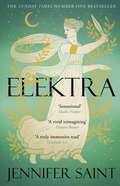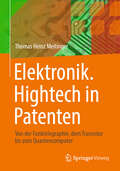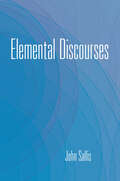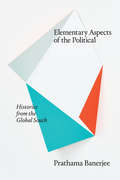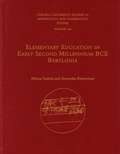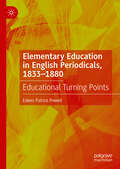- Table View
- List View
Electromagnetism and the Metonymic Imagination (AnthropoScene #4)
by Kieran M. MurphyHow does the imagination work? How can it lead to both reverie and scientific insight? In this book, Kieran M. Murphy sheds new light on these perennial questions by showing how they have been closely tied to the history of electromagnetism.The discovery in 1820 of a mysterious relationship between electricity and magnetism led not only to technological inventions—such as the dynamo and telegraph, which ushered in the “electric age”—but also to a profound reconceptualization of nature and the role the imagination plays in it. From the literary experiments of Edgar Allan Poe, Honoré de Balzac, Villiers de l’Isle-Adam, and André Breton to the creative leaps of Michael Faraday and Albert Einstein, Murphy illuminates how electromagnetism legitimized imaginative modes of reasoning based on a more acute sense of interconnection and a renewed interest in how metonymic relations could reveal the order of things.Murphy organizes his study around real and imagined electromagnetic devices, ranging from Faraday’s world-changing induction experiment to new types of chains and automata, in order to demonstrate how they provided a material foundation for rethinking the nature of difference and relation in physical and metaphysical explorations of the world, human relationships, language, and binaries such as life and death. This overlooked exchange between science and literature brings a fresh perspective to the critical debates that shaped the nineteenth century.Extensively researched and convincingly argued, this pathbreaking book addresses a significant lacuna in modern literary criticism and deepens our understanding of both the history of literature and the history of scientific thinking.
Electromagnetism and the Metonymic Imagination (AnthropoScene: The SLSA Book Series #4)
by Kieran M. MurphyHow does the imagination work? How can it lead to both reverie and scientific insight? In this book, Kieran M. Murphy sheds new light on these perennial questions by showing how they have been closely tied to the history of electromagnetism.The discovery in 1820 of a mysterious relationship between electricity and magnetism led not only to technological inventions—such as the dynamo and telegraph, which ushered in the "electric age"—but also to a profound reconceptualization of nature and the role the imagination plays in it. From the literary experiments of Edgar Allan Poe, Honoré de Balzac, Villiers de l’Isle-Adam, and André Breton to the creative leaps of Michael Faraday and Albert Einstein, Murphy illuminates how electromagnetism legitimized imaginative modes of reasoning based on a more acute sense of interconnection and a renewed interest in how metonymic relations could reveal the order of things.Murphy organizes his study around real and imagined electromagnetic devices, ranging from Faraday’s world-changing induction experiment to new types of chains and automata, in order to demonstrate how they provided a material foundation for rethinking the nature of difference and relation in physical and metaphysical explorations of the world, human relationships, language, and binaries such as life and death. This overlooked exchange between science and literature brings a fresh perspective to the critical debates that shaped the nineteenth century.Extensively researched and convincingly argued, this pathbreaking book addresses a significant lacuna in modern literary criticism and deepens our understanding of both the history of literature and the history of scientific thinking.
Electronic Baroque: Building a Historical Organ for the Present (Inside Technology)
by Peter F. PetersA fascinating, real-time ethnography of the building of a unique musical instrument with both mechanical and electronic components.Electronic Baroque tells the story of how a baroque pipe organ with both a mechanical and an electronic interface was built. The book also explores how, in musical practices, the new comes into being.In 2013, the Orgelpark in Amsterdam, a concert venue dedicated to organists who want to give their instrument a new role in musical life, embarked on a project to make a unique instrument. This new baroque organ project combined principles and practices from historically informed organ building with the design and application of new computer hardware and software. Drawing on hermeneutic, pragmatist, and post-actor network theoretical approaches to history and music, Peter Peters describes and analyzes how the dual design of the organ, facing both past and present, reiterates the long history of these instruments.
Electronic Value Exchange
by David L. StearnsElectronic Value Exchange examines in detail the transformation of the VISA electronic payment system from a collection of non-integrated, localized, paper-based bank credit card programs into the cooperative, global, electronic value exchange network it is today. Topics and features: provides a history of the VISA system from the mid-1960s to the early 1980s; presents a historical narrative based on research gathered from personal documents and interviews with key actors; investigates, for the first time, both the technological and social infrastructures necessary for the VISA system to operate; supplies a detailed case study, highlighting the mutual shaping of technology and social relations, and the influence that earlier information processing practices have on the way firms adopt computers and telecommunications; examines how "gateways" in transactional networks can reinforce or undermine established social boundaries, and reviews the establishment of trust in new payment devices.
Electronic and Experimental Music: Technology, Music, and Culture (Media And Popular Culture Ser.)
by Thom HolmesElectronic and Experimental Music: Technology, Music, and Culture provides a comprehensive history of electronic music, covering key composers, genres, and techniques used in analog and digital synthesis. This textbook has been extensively revised with the needs of students and instructors in mind. The reader-friendly style, logical organization, and pedagogical features of the fifth edition allow easy access to key ideas, milestones, and concepts. New to this edition: * A companion website, featuring key examples of electronic music, both historical and contemporary. * Listening Guides providing a moment-by-moment annotated exploration of key works of electronic music. * A new chapter--Contemporary Practices in Composing Electronic Music. * Updated presentation of classic electronic music in the United Kingdom, Italy, Latin America, and Asia, covering the history of electronic music globally. * An expanded discussion of early experiments with jazz and electronic music, and the roots of electronic rock. * Additional accounts of the vastly under-reported contributions of women composers in the field. * More photos, scores, and illustrations throughout. The companion website features a number of student and instructor resources, such as additional Listening Guides, links to streaming audio examples and online video resources, PowerPoint slides, and interactive quizzes.
Electronic and Experimental Music: Technology, Music, and Culture (Media And Popular Culture Ser.)
by Thom HolmesElectronic and Experimental Music: Technology, Music, and Culture, Sixth Edition, presents an extensive history of electronic music—from its historical beginnings in the late nineteenth century to its everchanging present—recounting the musical ideas that arose in parallel with technological progress. In four parts, the author details the fundamentals of electronic music, its history, the major synthesizer innovators, and contemporary practices. This examination of the music’s experimental roots covers the key composers, genres, and techniques used in analog and digital synthesis, including both art and popular music, Western and non-Western. NEW to this edition: A reorganized and revised chapter structure places technological advances within a historical framework Shorter chapters offer greater modularity and flexibility for instructors Discussions on the elements of sound, listening to electronic music, electronic music in the mainstream, Eurorack, and more An appendix of historically important electronic music studios around the globe Listening Guides throughout the book provide step-by-step annotations of key musical works, focusing the development of student listening skills. Featuring extensive revisions and expanded coverage, this sixth edition of Electronic and Experimental Music represents an comprehensive accounting of the technology, musical styles, and figures associated with electronic music, highlighting the music’s deep cultural impact.
Electronica, Dance and Club Music (The\library Of Essays On Popular Music Ser.)
by Mark J. ButlerDiscos, clubs and raves have been focal points for the development of new and distinctive musical and cultural practices over the past four decades. This volume presents the rich array of scholarship that has sprung up in response. Cutting-edge perspectives from a broad range of academic disciplines reveal the complex questions provoked by this musical tradition. Issues considered include aesthetics; agency; 'the body' in dance, movement, and space; composition; identity (including gender, sexuality, race, and other constructs); musical design; place; pleasure; policing and moral panics; production techniques such as sampling; spirituality and religion; sub-cultural affiliations and distinctions; and technology. The essays are contributed by an international group of scholars and cover a geographically and culturally diverse array of musical scenes.
Elegant Country and Suburban Houses of the Twenties
by Charles S. KeefeThis handsomely illustrated book showcases outstanding examples of suburban and country houses of the 1920s—a great period for domestic architecture in the United States. Lovely photographs present exterior and interior views of 51 classic homes, primarily in the metropolitan area of New York City, as well as other suburbs on the east coast and in California.A variety of distinctive architectural styles are depicted, from a simple Long Island Dutch colonial to an elegant Spanish villa in California with courtyard and terrace. Floor plans as well as interior and exterior views display an array of striking arrangements: central buildings with flanking wings and pavilions, arched passageways, kitchens with pantries, sun porches, servants' rooms, and even a "men's dining room"; while photographs depict such architectural details as sweeping staircases, gardens and pools, and decorative cornices, chimney caps, and fireplace mantels.An ideal reference for preservationists and home restorers, this volume will delight enthusiasts of gracious architecture of the 1920s.
Elegant Etiquette in the Nineteenth Century
by Mallory James&“A scholarly guide to etiquette as entertaining and amusing as a work of fiction&” (Jane Austen&’s Regency World Magazine). Have you ever wondered what it would have been like to live in the nineteenth century? How would you have gotten a partner in a ballroom? What would you have done with a letter of introduction? And where would you have sat in a carriage? Covering all these nineteenth-century dilemmas and more, this book is your must-have guide to the etiquette of our well-heeled forebears. As it takes you through the intricacies of rank, the niceties of the street, the good conduct that was desired in the ballroom, and the awkward blunders that a lady or gentleman would have wanted to avoid, you will discover an abundance of etiquette advice from across the century, and a lively, occasionally tongue-in-cheek, and thoroughly detailed history of nineteenth-century manners and conduct. This well-researched book is enjoyable, compelling reading for anyone with an interest in this period. In exploring the expectations of behavior and etiquette, it brings the world of the nineteenth century to life.
Elegant Small Homes of the Twenties: 99 Designs from a Competition (Dover Architecture)
by Chicago TribuneIn 1927, the Chicago Tribune sponsored a competition for "trained men of talent, incorporating into the small home ideas of real worth, types of rare charm, and the best possible plans for comfort and convenience." This collection spotlights the challenge's top results, presenting the nineteen prize-winning designs for five- and six-room houses, plus eighty additional sets of the best architectural plans. A new introduction by Daniel D. Reiff, Ph.D., adds interesting detail about the competition and the competitors. These fascinating snapshots of American domestic architecture of the 1920s include glimpses of New England and Southern colonials, Normandy cottages, stately Italianate dwellings, and other styles. Each of the designs features a floor plan and exterior views of the house. Architects, architecture buffs, and historians will prize these authentic renderings of the leading designs in American architecture of nearly a century ago.
Elegia per Melusine: Una Favola Medioevale
by Claire DelacroixCondannata da una maledizione a cambiare forma un giorno a settimana, Melusine sa che solo l'amore può renderla libera. Quando incontra Raymond, un affascinante cavaliere con un disperato bisogno di aiuto che solo lei può soddisfare, crede che la sua occasione sia arrivata. Giura di diventarne la moglie devota e di guadagnarsi il suo amore, anche se sceglie di tenere segreta la sua maledizione. Quando la loro felice unione viene messa alla prova dalla sfortuna, Raymond giura di dimostrare che le malelingue si sbagliano. Sarà tentato di rompere la sua promessa a Melusine per scoprire la verità? E l'amore per la sua sposa sopravvivrà se il segreto di lei verrà svelato?
Elegy Landscapes: Constable And Turner And The Intimate Sublime
by Stanley PlumlyA sweeping look at the lives and work of two important English Romantic painters, from a Los Angeles Times Book Prize–winning author. Renowned poet Stanley Plumly, who has been praised for his “obsessive, intricate, intimate and brilliant” (Washington Post) nonfiction, explores immortality in art through the work of two impressive landscape artists: John Constable and J.M.W. Turner. How is it that this disparate pair will come to be regarded as Britain’s supreme landscape painters, precursors to Impressionism and Modernism? How did each painter’s life influence his work? Almost exact contemporaries, both legendary artists experience a life-changing tragedy—for Constable it is the long illness and death of his wife; for Turner, the death of his singular parent and supporter, his father. Their work will take on new power thereafter: Constable, his Hampstead cloud studies; Turner, his Venetian watercolors and oils. Seeking the transcendent aesthetic awe of the sublime and reeling from their personal anguish, these talented painters portrayed the terrible beauty of the natural world from an intimate, close-up perspective. Plumly studies the paintings against the pull of the artists’ lives, probing how each finds the sublime in different, though inherently connected, worlds. At once a meditation on the difficulties in achieving truly immortal works of art and an exploration of the relationship between artist and artwork, Elegy Landscapes takes a wide-angle look at the philosophy of the sublime.
Elegy for Eddie: A Maisie Dobbs Novel (Maisie Dobbs #9)
by Jacqueline WinspearMaisie Dobbs--psychologist, investigator, and "one of the great fictional heroines, equal parts haunted and haunting" (Parade)--returns in a chilling adventure, the latest chapter in Jacqueline Winspear's bestselling series. Early April 1933. To the costermongers of Covent Garden--sellers of fruit and vegetables on the streets of London--Eddie Pettit was a gentle soul with a near-magical gift for working with horses. When Eddie is killed in a violent accident, the grieving costers are deeply skeptical about the cause of his death. Who would want to kill Eddie--and why? Maisie Dobbs' father, Frankie, had been a costermonger, so she had known the men since childhood. She remembers Eddie fondly and is determined to offer her help. But it soon becomes clear that powerful political and financial forces are equally determined to prevent her from learning the truth behind Eddie's death. Plunging into the investigation, Maisie begins her search for answers on the working-class streets of Lambeth where Eddie had lived and where she had grown up. The inquiry quickly leads her to a callous press baron; a has-been politician named Winston Churchill, lingering in the hinterlands of power; and, most surprisingly, to Douglas Partridge, the husband of her dearest friend, Priscilla. As Maisie uncovers lies and manipulation on a national scale, she must decide whether to risk it all to see justice done. The story of a London affected by the march to another war years before the first shot is fired and of an innocent victim caught in the crossfire, Elegy for Eddie is Jacqueline Winspear's most poignant and powerful novel yet.
Elegy for Kosovo: Stories
by Peter Constantine Ismail KadareJune 28, 1389: Six hundred years before Serbian leader Slobodan Milosevic called for the repression of the Albanian majority in Kosovo, there took place, on the Field of the Blackbirds, a battle shrouded in legend. A coalition of Serbs, Albanian Catholics, Bosnians, and Rumanians confronted and fell to the invading Ottoman army of Sultan Murad. The battle established the Muslim foothold in Europe and became a centerpiece of Serbian nationalist ideology, justifying the campaign of ethnic cleansing of Albanian Kosovars that the world witnessed with horror at the end of the last century. In this eloquent and timely reflection on war, memory, and the destiny of two peoples, Ismail Kadare explores in fiction the legend and the consequences of that defeat. Elegy for Kosovo is a heartfelt yet clear-eyed lament for a land riven by hatreds as old as the Homeric epics and as young as the latest news broadcast.
Elegy for Mary Turner: An Illustrated Account of a Lynching
by Rachel Marie-Crane WilliamsA lyrical and haunting depiction of American racial violence and lynching, evoked through stunning full-color artworkIn late May 1918 in Valdosta, Georgia, ten Black men and one Black woman—Mary Turner, eight months pregnant at the time—were lynched and tortured by mobs of white citizens.Through hauntingly detailed full-color artwork and collage, Elegy for Mary Turner names those who were killed, identifies the killers, and evokes a landscape in which the NAACP investigated the crimes when the state would not and a time when white citizens baked pies and flocked to see Black corpses while Black people fought to make their lives—and their mourning—matter.Included are contributions from C. Tyrone Forehand, great-grandnephew of Mary and Hayes Turner, whose family has long campaigned for the deaths to be remembered; abolitionist activist and educator Mariame Kaba, reflecting on the violence visited on Black women&’s bodies; and historian Julie Buckner Armstrong, who opens a window onto the broader scale of lynching&’s terror in American history.
Elektra
by SophoclesAmong the most celebrated plays of ancient Athens, Elektra is one of seven surviving dramas by the great Greek playwright, Sophocles, now available from Harper Perennial in a vivid and dynamic new translation by award-winning poet Robert Bagg. Elektra masterfully explores the consequences of revenge—both for those who bear the brunt of violence and for those who become obsessed by hatred under its influence—as it focuses on the cycle of bloodshed that consumes a royal family. This is Sophocles, vibrant and alive, for a new generation.
Elektra: The mesmerising retelling from the women at the heart of the Trojan War
by Jennifer Saint**The spellbinding new retelling of the Trojan War drawn from the perspective of the fearless women at the heart of it all.**'The story and its characters swept me up and engulfed me, I could not put this one down' ⭐ ⭐ ⭐ ⭐ ⭐ REAL READER REVIEW'I was glued to it from beginning to end and could not wait to recommend to my friends afterwards.' ⭐ ⭐ ⭐ ⭐ ⭐ REAL READER REVIEW'Jennifer Saint has breathed new life into this myth and put her own stamp on it' ⭐ ⭐ ⭐ ⭐ ⭐ REAL READER REVIEW'A brilliant read' Women & Home | 'A spirited retelling' Times | 'Beautiful and absorbing' Fabulous | 'A vivid reimagining of Greek mythology' Harper's Bazaar | 'Jennifer Saint has done an incredible job' RedThe House of Atreus is cursed. A bloodline tainted by a generational cycle of violence and vengeance. This is the story of three women, their fates inextricably tied to this curse, and the fickle nature of men and gods.ClytemnestraThe sister of Helen, wife of Agamemnon - her hopes of averting the curse are dashed when her sister is taken to Troy by the feckless Paris. Her husband raises a great army against them and determines to win, whatever the cost.CassandraPrincess of Troy, and cursed by Apollo to see the future but never to be believed when she speaks of it. She is powerless in her knowledge that the city will fall.ElektraThe youngest daughter of Clytemnestra and Agamemnon, Elektra is horrified by the bloodletting of her kin. But can she escape the curse, or is her own destiny also bound by violence?Praise for Jennifer Saint and ARIADNE:'A lyrical, insightful re-telling' Daily Mail'Relevant and revelatory' Stylist'Energetic and compelling' Times'An illuminating read' Woman & Home'A story that's impossible to forget' Culturefly
Elektra: The mesmerising story of Troy from the three women its heart
by Jennifer Saint**The spellbinding new retelling of the story of Troy drawn from the perspective of the fearless women at the heart of it all.**'The story and its characters swept me up and engulfed me, I could not put this one down' ⭐ ⭐ ⭐ ⭐ ⭐ REAL READER REVIEW'I was glued to it from beginning to end and could not wait to recommend to my friends afterwards.' ⭐ ⭐ ⭐ ⭐ ⭐ REAL READER REVIEW'Jennifer Saint has breathed new life into this myth and put her own stamp on it' ⭐ ⭐ ⭐ ⭐ ⭐ REAL READER REVIEW'A brilliant read' Women & Home | 'A spirited retelling' Times | 'Beautiful and absorbing' Fabulous | 'A vivid reimagining of Greek mythology' Harper's Bazaar | 'Jennifer Saint has done an incredible job' RedThe House of Atreus is cursed. A bloodline tainted by a generational cycle of violence and vengeance. This is the story of three women, their fates inextricably tied to this curse, and the fickle nature of men and gods.ClytemnestraThe sister of Helen, wife of Agamemnon - her hopes of averting the curse are dashed when her sister is taken to Troy by the feckless Paris. Her husband raises a great army against them and determines to win, whatever the cost.CassandraPrincess of Troy, and cursed by Apollo to see the future but never to be believed when she speaks of it. She is powerless in her knowledge that the city will fall.ElektraThe youngest daughter of Clytemnestra and Agamemnon, Elektra is horrified by the bloodletting of her kin. But can she escape the curse, or is her own destiny also bound by violence?Praise for Jennifer Saint and ARIADNE:'A lyrical, insightful re-telling' Daily Mail'Relevant and revelatory' Stylist'Energetic and compelling' Times'An illuminating read' Woman & Home'A story that's impossible to forget' Culturefly
Elektronik. Hightech in Patenten: Von der Funktelegraphie, dem Transistor bis zum Quantencomputer
by Thomas Heinz MeitingerElektronische Schaltungen werden heutzutage zumeist aus kristallinen Halbleitern hergestellt, in die Fremdatome eingebracht werden (Dotierung). Die Anfänge der Elektronik kennzeichnen jedoch die Elektronenröhren, mit denen die ersten gleichrichtenden und schaltenden Funktionen verwirklicht wurden. Die ersten, auf dieser Technologie basierenden Computer hatten eine geringe Leistung, wiesen dennoch gewaltige räumliche Ausmaße auf. Erst mit der Verwendung von dotierten Halbleitern begann die Miniaturisierung und die dynamische Entwicklung der Elektronik. Dieses Buch zeigt die Entwicklung der hierfür erforderlichen Elektronik von der Analogtechnik mit den Operationsverstärkern über die Digitaltechnik, die letzten Endes ins Computerzeitalter geführt hat, und der Hochfrequenztechnik, die entscheidend die Nachrichtenübertragung bestimmt hat, bis hin zur Leistungselektronik, die eine elektrische Energieversorgung ermöglicht. In diesem Buch werden die hierfür benötigten Erfindungen und die resultierende technische Entwicklung anhand der Hauptansprüche und Zeichnungen aus Patentschriften vorgestellt.
Elemental Discourses (The\collected Writings Of John Sallis Ser. #Ii, 4)
by John Sallis“A remarkable collection of essays that serve as a rewarding introduction to the more mature thought of Sallis . . . a feast of discourse.” —Notre Dame Philosophical ReviewsJohn Sallis’s thought is oriented to two overarching tasks: to bring to light the elemental in nature and to show how the imagination operates at the very center of human experience. He undertakes these tasks by analyzing a broad range of phenomena, including perception, the body, the natural world, art, space, and the cosmos. In every case, Sallis develops an original form of discourse attuned to the specific phenomenon and enacts a thorough reflection on discourse itself in its relation to voice, dialogue, poetry, and translation. Sallis’s systematic investigations are complemented by his extensive interpretations of canonical figures in the history of philosophy such as Plato, Aristotle, Kant, Schelling, and Hegel and by his engagement with the most original thinkers in the areas of phenomenology, hermeneutics, and deconstruction.
Elementary Aspects of the Political: Histories from the Global South (Theory in Forms)
by Prathama BanerjeeIn Elementary Aspects of the Political Prathama Banerjee moves beyond postcolonial and decolonial critiques of European political philosophy to rethink modern conceptions of "the political" from the perspective of the global South. Drawing on Indian and Bengali practices and philosophies from the late nineteenth and early twentieth centuries, Banerjee identifies four elements of the political: the self, action, the idea, and the people. She examines selfhood in light of precolonial Indic traditions of renunciation and realpolitik; action in the constitutive tension between traditional conceptions of karma and modern ideas of labor; the idea of equality as it emerges in the dialectic between spirituality and economics; and people in the friction between the structure of the political party and the atmospherics of fiction and theater. Throughout, Banerjee reasserts the historical specificity of political thought and challenges modern assumptions about the universality, primacy, and self-evidence of the political. In formulating a new theory of the political, Banerjee gestures toward a globally salient political philosophy that displaces prevailing Western notions of the political masquerading as universal.
Elementary Education in Early Second Millennium BCE Babylonia (CUSAS)
by Alhena Gadotti Alexandra KleinermanIn this volume, Alhena Gadotti and Alexandra Kleinerman investigate how Akkadian speakers learned Sumerian during the Old Babylonian period in areas outside major cities. Despite the fact that it was a dead language at the time, Sumerian was considered a crucial part of scribal training due to its cultural importance. This book provides transliterations and translations of 715 cuneiform scribal school exercise texts from the Jonathan and Jeanette Rosen Ancient Near Eastern Studies Collection at Cornell University. These tablets, consisting mainly of lexical texts, illustrate the process of elementary foreign-language training at scribal schools during the Old Babylonian period. Although the tablets are all without provenance, discrepancies between these texts and those from other sites, such as Nippur and Ur, strongly suggest that the texts published here do not come from a previously studied location. Comparing these tablets with previously published documents, Gadotti and Kleinerman argue that elementary education in Mesopotamia was relatively standardized and that knowledge of cuneiform writing was more widespread than previously assumed.By refining our understanding of education in southern Mesopotamia, this volume elucidates more fully the pedagogical underpinnings of the world’s first curriculum devised to teach a dead language. As a text edition, it will make these important documents accessible to Assyriologists and Sumerologists for future study.
Elementary Education in Early Second Millennium BCE Babylonia (CUSAS: Cornell University Studies in Assyriology and Sumerology #42)
by Alhena Gadotti Alexandra KleinermanIn this volume, Alhena Gadotti and Alexandra Kleinerman investigate how Akkadian speakers learned Sumerian during the Old Babylonian period in areas outside major cities. Despite the fact that it was a dead language at the time, Sumerian was considered a crucial part of scribal training due to its cultural importance. This book provides transliterations and translations of 715 cuneiform scribal school exercise texts from the Jonathan and Jeanette Rosen Ancient Near Eastern Studies Collection at Cornell University. These tablets, consisting mainly of lexical texts, illustrate the process of elementary foreign-language training at scribal schools during the Old Babylonian period. Although the tablets are all without provenance, discrepancies between these texts and those from other sites, such as Nippur and Ur, strongly suggest that the texts published here do not come from a previously studied location. Comparing these tablets with previously published documents, Gadotti and Kleinerman argue that elementary education in Mesopotamia was relatively standardized and that knowledge of cuneiform writing was more widespread than previously assumed.By refining our understanding of education in southern Mesopotamia, this volume elucidates more fully the pedagogical underpinnings of the world’s first curriculum devised to teach a dead language. As a text edition, it will make these important documents accessible to Assyriologists and Sumerologists for future study.
Elementary Education in English Periodicals, 1833-1880: Educational Turning Points
by Edwin Patrick PowellThe nature and purpose of elementary education featured prominently in English periodicals throughout the nineteenth century. This book’s central argument is that the periodical press provided a unique cultural space for literary and intellectual contributions to sustained debates about education. Furthermore, political, economic, social, religious, literary, and cultural developments converged with pivotal educational turning points featured in periodicals that affirmed the creative force of education. However, relatively little scholarly attention has been given to periodicals as a medium for exploring the tension between competing educational ideas and practices in Victorian England. This book therefore reassesses elementary education through the new literary perspectives of periodical culture.

